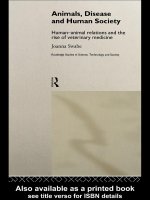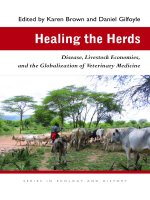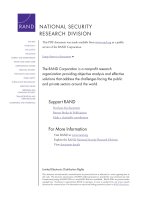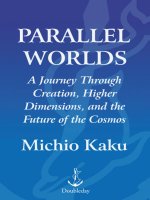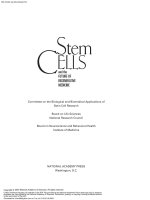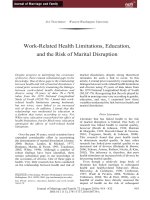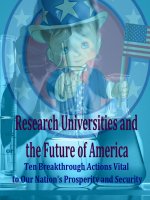Stem CELLS and the FUTURE OF REGENERATIVE MEDICINE pdf
Bạn đang xem bản rút gọn của tài liệu. Xem và tải ngay bản đầy đủ của tài liệu tại đây (5.65 MB, 112 trang )
Committee on the Biological and Biomedical Applications of
Stem Cell Research
Board on Life Sciences
National Research Council
Board on Neuroscience and Behavioral Health
Institute of Medicine
NATIONAL ACADEMY PRESS
Washington, D.C.
Stem
C
ELLS
and the
FUTURE OF
REGENERATIVE
MEDICINE
Copyright ©
2003 National Academy of Sciences. All rights reserved.
Unless otherwise indicated, all materials in this PDF File provided by the National Academies Press (www.nap.edu) for research
purposes are copyrighted by the National Academy of Sciences. Distribution, posting, or copying is strictly prohibited without
written permission of the NAP.
Generated for on Tue Jul 15 05:51:08 2003
/>NATIONAL ACADEMY PRESS 2101 Constitution Avenue, N.W. Washington, DC 20418
NOTICE: The project that is the subject of this report was approved by the Governing
Board of the National Research Council, whose members are drawn from the councils of
the National Academy of Sciences, the National Academy of Engineering, and the
Institute of Medicine. The members of the committee responsible for the report were
chosen for their special competencies and with regard for appropriate balance.
This study was supported by the National Research Council Fund and by the Ellison
Medical Foundation under Agreement no. NI-CW-0007-01. Any opinions, findings,
conclusions, or recommendations expressed in this publication are those of the authors
and do not necessarily reflect the views of the organizations or agencies that provided
support for the project.
Library of Congress Cataloging-in-Publication Data
Stem cells and the future of regenerative medicine / Committee on the
Biological and Biomedical Applications of Stem Cell Research, Commission
on Life Sciences National Research Council.
p. cm.
Includes bibliographical references and index.
ISBN 0-309-07630-7
1. Stem cells—Research—Government policy—United States. I.
National Research Council (U.S.). Committee on the Biological and
Biomedical Applications of Stem Cell Research.
QH587 .S726 2001
571.8′35—dc21
2001006360
Cover: Background image courtesy of Musee National du Chateau de Malmaison, Rueil-
Malmaison/Lauros-Giraudon, Paris/SuperStock; stem cell photo courtesy of James
Thomson Laboratory, University of Wisconsin Board of Regents.
Additional copies of this report are available from National Academy Press, 2101
Constitution Avenue, NW, Lockbox 285, Washington, DC 20055; (800) 624-6242 or
(202) 334-3313 (in the Washington metropolitan area); Internet,
Printed in the United States of America.
Copyright 2002 by the National Academy of Sciences. All rights reserved.
Copyright ©
2003 National Academy of Sciences. All rights reserved.
Unless otherwise indicated, all materials in this PDF File provided by the National Academies Press (www.nap.edu) for research
purposes are copyrighted by the National Academy of Sciences. Distribution, posting, or copying is strictly prohibited without
written permission of the NAP.
Generated for on Tue Jul 15 05:51:08 2003
/>The National Academy of Sciences is a private, nonprofit, self-perpetuating society of
distinguished scholars engaged in scientific and engineering research, dedicated to the
furtherance of science and technology and to their use for the general welfare. Upon the
authority of the charter granted to it by the Congress in 1863, the Academy has a
mandate that requires it to advise the federal government on scientific and technical
matters. Dr. Bruce M. Alberts is president of the National Academy of Sciences.
The National Academy of Engineering was established in 1964, under the charter of the
National Academy of Sciences, as a parallel organization of outstanding engineers. It is
autonomous in its administration and in the selection of its members, sharing with the
National Academy of Sciences the responsibility for advising the federal government.
The National Academy of Engineering also sponsors engineering programs aimed at
meeting national needs, encourages education and research, and recognizes the superior
achievements of engineers. Dr. Wm. A. Wulf is president of the National Academy of
Engineering.
The Institute of Medicine was established in 1970 by the National Academy of Sciences
to secure the services of eminent members of appropriate professions in the examination
of policy matters pertaining to the health of the public. The Institute acts under the
responsibility given to the National Academy of Sciences by its congressional charter to
be an adviser to the federal government and, upon its own initiative, to identify issues of
medical care, research, and education. Dr. Kenneth I. Shine is president of the Institute
of Medicine.
The National Research Council was organized by the National Academy of Sciences in
1916 to associate the broad community of science and technology with the Academy’s
purposes of furthering knowledge and advising the federal government. Functioning in
accordance with general policies determined by the Academy, the Council has become
the principal operating agency of both the National Academy of Sciences and the
National Academy of Engineering in providing services to the government, the public,
and the scientific and engineering communities. The Council is administered jointly by
both Academies and the Institute of Medicine. Dr. Bruce M. Alberts and Dr. Wm. A.
Wulf are chairman and vice chairman, respectively, of the National Research Council.
National Academy of Sciences
National Academy of Engineering
Institute of Medicine
National Research Council
Copyright ©
2003 National Academy of Sciences. All rights reserved.
Unless otherwise indicated, all materials in this PDF File provided by the National Academies Press (www.nap.edu) for research
purposes are copyrighted by the National Academy of Sciences. Distribution, posting, or copying is strictly prohibited without
written permission of the NAP.
Generated for on Tue Jul 15 05:51:08 2003
/>iv
COMMITTEE ON THE BIOLOGICAL AND BIOMEDICAL
APPLICATIONS OF STEM CELL RESEARCH
BERT VOGELSTEIN (Chair), Johns Hopkins Oncology Center,
Baltimore, and Howard Hughes Medical Institute
BARRY R. BLOOM, Harvard School of Public Health, Cambridge,
Massachusetts
COREY S. GOODMAN, University of California, Berkeley, and
Howard Hughes Medical Institute
PATRICIA A. KING, Georgetown University Law Center,
Washington, D.C.
GUY M. MCKHANN, Johns Hopkins University School of Medicine,
Baltimore
MYRON L. WEISFELDT, Columbia University College of Physicians
and Surgeons, New York
KATHLEEN R. MERIKANGAS (liaison, Board on Neuroscience and
Behavioral Health), Yale University, New Haven, Connecticut
Project Staff
FRANCES E. SHARPLES, Director, Board on Life Sciences
TERRY C. PELLMAR, Director, Board on Neuroscience and
Behavioral Health
ROBIN A. SCHOEN, Program Officer
JANET E. JOY, Senior Program Officer
BRIDGET K. B. AVILA, Senior Project Assistant
LAURA T. HOLLIDAY, Research Assistant
DEREK M. SWEATT, Research Assistant
NORMAN GROSSBLATT, Senior Editor
Copyright ©
2003 National Academy of Sciences. All rights reserved.
Unless otherwise indicated, all materials in this PDF File provided by the National Academies Press (www.nap.edu) for research
purposes are copyrighted by the National Academy of Sciences. Distribution, posting, or copying is strictly prohibited without
written permission of the NAP.
Generated for on Tue Jul 15 05:51:08 2003
/>v
BOARD ON LIFE SCIENCES
NATIONAL RESEARCH COUNCIL
COREY S. GOODMAN (Chair), University of California, Berkeley
MICHAEL T. CLEGG, University of California, Riverside
DAVID S. EISENBERG, University of California, Los Angeles
DAVID J. GALAS, Keck Graduate Institute of Applied Life Science,
Claremont, California
BARBARA GASTEL, Texas A&M University, College Station
JAMES M. GENTILE, Hope College, Holland, Michigan
DAVID V. GOEDDEL, Tularik, Inc., South San Francisco, California
ELLIOT M. MEYEROWITZ, California Institute of Technology,
Pasadena
ROBERT T. PAINE, University of Washington, Seattle
STUART L. PIMM, Columbia University, New York
JOAN B. ROSE, University of South Florida, St. Petersburg
GERALD M. RUBIN, Howard Hughes Medical Institute, Chevy
Chase, Maryland
RONALD R. SEDEROFF, North Carolina State University, Raleigh
ROBERT R. SOKAL, State University of New York, Stony Brook
SHIRLEY M. TILGHMAN, Princeton University, New Jersey
RAYMOND L. WHITE, DNA Sciences, Inc., Fremont, California
Staff
FRANCES E. SHARPLES, Director
JENNIFER KUZMA, Senior Program Officer
KERRY A. BRENNER, Program Officer
JOAN G. ESNAYRA, Program Officer
ROBIN A. SCHOEN, Program Officer
MARILEE K. SHELTON, Program Officer
ROBERT T. YUAN, Program Officer
LAURA T. HOLLIDAY, Research Assistant
DEREK M. SWEATT, Research Assistant
BRIDGET K.B. AVILA, Senior Project Assistant
DENISE D. GROSSHANS, Project Assistant
Copyright ©
2003 National Academy of Sciences. All rights reserved.
Unless otherwise indicated, all materials in this PDF File provided by the National Academies Press (www.nap.edu) for research
purposes are copyrighted by the National Academy of Sciences. Distribution, posting, or copying is strictly prohibited without
written permission of the NAP.
Generated for on Tue Jul 15 05:51:08 2003
/>vi
BOARD ON NEUROSCIENCE AND BEHAVIORAL HEALTH
INSTITUTE OF MEDICINE
ANN M. GRAYBIEL (Chair), Massachusetts Institute of Technology,
Cambridge
KENNETH B. WELLS (Vice-Chair), Neuropsychiatric Institute,
University of California, Los Angeles
NANCY E. ADLER, University of California, San Francisco
RICHARD J. BONNIE, University of Virginia School of Law,
Charlottesville
WILLIAM E. BUNNEY, University of California, Irvine
RICHARD G. FRANK, Harvard Medical School, Boston,
Massachusetts
JEROME KAGAN, Harvard University, Cambridge, Massachusetts
HERBERT D. KLEBER, Columbia University and New York State
Psychiatric Institute, New York
BEVERLY B. LONG, World Federation for Mental Health, Atlanta,
Georgia
KATHLEEN R. MERIKANGAS, Yale University, New Haven,
Connecticut
STEVEN M. MIRIN, American Psychiatric Association,
Washington, D.C.
STEVEN M. PAUL, Lilly Research Laboratories, Indianapolis, Indiana
DAVID REISS, George Washington University Medical Center,
Washington, D.C.
RHONDA J. ROBINSON-BEALE, Blue Cross/Blue Shield of
Michigan, Southfield
STEPHEN WAXMAN, Yale Medical School, New Haven,
Connecticut
NANCY S. WEXLER, Columbia University, New York
ANNE B. YOUNG, Massachusetts General Hospital, Boston
Staff
TERRY C. PELLMAR, Director
SARA K. GOLDSMITH, Senior Program Officer
JANET E. JOY, Senior Program Officer
ALLISON L. FRIEDMAN, Research Assistant
LORA K. TAYLOR, Administrative Assistant
ALLISON M. PANZER, Project Assistant
Copyright ©
2003 National Academy of Sciences. All rights reserved.
Unless otherwise indicated, all materials in this PDF File provided by the National Academies Press (www.nap.edu) for research
purposes are copyrighted by the National Academy of Sciences. Distribution, posting, or copying is strictly prohibited without
written permission of the NAP.
Generated for on Tue Jul 15 05:51:08 2003
/>T
Acknowledgments
vii
his report is the product of many individuals. First, we would
like to thank all the speakers who attended our workshop,
Stem Cells and the Future of Regenerative Medicine, on June
22, 2001. Without the input of each of these speakers, this
report would not have been possible.
Iqbal Ahmad, University of Nebraska Medical Center
George Annas, Boston University Schools of Medicine and
Public Health
Ernest Beutler, Scripps Research Institute
Kevin FitzGerald, Georgetown University
Fred Gage, Salk Institute
Margaret Goodell, Taylor College of Medicine
Marcus Grompe, Oregon Health Sciences University
Ihor Lemischka, Princeton University
Olle Lindvall, Lund University
Ron McKay, National Institute of Neurological Disorders
and Stroke
Thomas Okarma, Geron Corporation
David Prentice, Indiana State University
Arti Rai, University of Pennsylvania School of Law
Jay Siegel, Food and Drug Administration
James Thomson, University of Wisconsin
LeRoy Walters, Georgetown University
Irving Weissman, Stanford University
Copyright ©
2003 National Academy of Sciences. All rights reserved.
Unless otherwise indicated, all materials in this PDF File provided by the National Academies Press (www.nap.edu) for research
purposes are copyrighted by the National Academy of Sciences. Distribution, posting, or copying is strictly prohibited without
written permission of the NAP.
Generated for on Tue Jul 15 05:51:08 2003
/>viii
STEM CELLS AND THE FUTURE OF REGENERATIVE MEDICINE
Second, this report has been reviewed in draft form by individuals
chosen for their diverse perspectives and technical expertise, in accor-
dance with procedures approved by the NRC’s Report Review Commit-
tee. The purpose of this independent review is to provide candid and
critical comments that will assist the institution in making its published
report as sound as possible and to ensure that the report meets institu-
tional standards for objectivity, evidence, and responsiveness to the study
charge. The review comments and draft manuscript remain confidential
to protect the integrity of the deliberative process. We wish to thank the
following individuals for their review of this report:
Fred Alt, Howard Hughes Medical Institute, Harvard Medical School
Fred Appelbaum, Fred Hutchinson Cancer Research Center
Daniel Callahan, The Hastings Center
R. Alta Charo, University of Wisconsin Law School
Carolyn Compton, McGill University
William Danforth, Washington University
Neal First, University of Wisconsin
Barbara Gastel, Texas A&M University
John Gerhart, University of California, Berkeley
Paul Gilman, Celera Genomics
Micheline Mathews-Roth, Harvard Medical School
Martin Raff, University College London
Nathan Rosenberg, Stanford University
Evan Snyder, Boston Children’s Hospital
Virginia Weldon, Monsanto Company
Although the reviewers listed above have provided many constructive
comments and suggestions, they were not asked to endorse the conclu-
sions or recommendations nor did they see the final draft of the report
before its release. The review of this report was overseen by Ronald
Estabrook of the University of Texas Southwestern Medical Center and
Floyd Bloom of the Scripps Research Institute. Appointed by the
Copyright ©
2003 National Academy of Sciences. All rights reserved.
Unless otherwise indicated, all materials in this PDF File provided by the National Academies Press (www.nap.edu) for research
purposes are copyrighted by the National Academy of Sciences. Distribution, posting, or copying is strictly prohibited without
written permission of the NAP.
Generated for on Tue Jul 15 05:51:08 2003
/>Acknowledgments
ix
National Research Council, they were responsible for making certain that
an independent examination of this report was carried out in accordance
with institutional procedures and that all review comments were carefully
considered. Responsibility for the final content of this report rests
entirely with the authoring committee and the institution.
Copyright ©
2003 National Academy of Sciences. All rights reserved.
Unless otherwise indicated, all materials in this PDF File provided by the National Academies Press (www.nap.edu) for research
purposes are copyrighted by the National Academy of Sciences. Distribution, posting, or copying is strictly prohibited without
written permission of the NAP.
Generated for on Tue Jul 15 05:51:08 2003
/>Copyright ©
2003 National Academy of Sciences. All rights reserved.
Unless otherwise indicated, all materials in this PDF File provided by the National Academies Press (www.nap.edu) for research
purposes are copyrighted by the National Academy of Sciences. Distribution, posting, or copying is strictly prohibited without
written permission of the NAP.
Generated for on Tue Jul 15 05:51:08 2003
/>tem cell research has the potential to affect the lives of mil-
lions of people in the United States and around the world.
This research is now regularly front-page news because of the
controversy surrounding the derivation of stem cells from
human embryos. Realizing the promise of stem cells for
yielding new medical therapies will require us to grapple with
more than just scientific uncertainties. The stem cell debate
has led scientists and nonscientists alike to contemplate
profound issues, such as who we are and what makes us
human beings.
The excitement and controversy surrounding stem cells
caused the National Research Council’s Board on Life Sci-
ences and the Institute of Medicine’s Board on Neuroscience
and Behavioral Health to recommend that the National
Academies sponsor a workshop to assess the scientific and
therapeutic value of stem cells. The presidents of the National
Academies agreed and provided most of the funding that
supported the production of this report. The Ellison Founda-
tion provided additional funding.
In a collaboration of the two boards, the Committee on
the Biological and Biomedical Applications of Stem Cell
Research was formed. The persons appointed to serve on the
committee have a wealth of expertise in the basic and clinical
biomedical sciences but do not themselves perform stem cell
S
Preface
xi
Copyright ©
2003 National Academy of Sciences. All rights reserved.
Unless otherwise indicated, all materials in this PDF File provided by the National Academies Press (www.nap.edu) for research
purposes are copyrighted by the National Academy of Sciences. Distribution, posting, or copying is strictly prohibited without
written permission of the NAP.
Generated for on Tue Jul 15 05:51:08 2003
/>xii
STEM CELLS AND THE FUTURE OF REGENERATIVE MEDICINE
research. The latter characteristic was intended to ensure that none of
the committee members had a vested interest in any form of stem cell
research. Expertise represented on the committee includes molecular
biology, immunology, cell biology, cardiology, hematology, neuro-
sciences, developmental biology, infectious disease, cancer, and bioethics,
all of which are integrally related to stem cell research and its potential
for developing tissue-replacement therapies that will restore lost function
in damaged organs.
At the committee’s workshop, held on June 22, 2001, scientists,
philosophers, ethicists, and legal experts presented their views in two
general categories. First, leading scientific investigators addressed the
following scientific questions: What are stem cells? What are their
sources, and what biological differences exist among cells of different
origins? How do these differences translate into advantages or disadvan-
tages for research and medical applications? What is the potential of
stem cells for regenerative medicine, and what obstacles must be over-
come to make them useful for new medical therapies? Second, experts in
philosophy, law, and ethics presented a variety of ethical and other
arguments relevant to public-policy considerations on stem cells. Audio
files of the speakers’ presentations are available until December 31, 2002,
at the workshop Web site: www.nationalacademies.org/stemcells.
This report presents the committee’s findings and recommendations.
It is based on careful consideration of information presented at the
workshop and on data and opinions found in the scientific and other
scholarly literature. The committee is extremely respectful of all perspec-
tives in this debate and has taken them into account in forming its
recommendations.
I wish to thank all the members of the committee for their valuable
contributions and especially for their insights into both the scientific and
the societal issues. In particular, Corey Goodman, chair of the Board on
Life Sciences, was responsible for much of the initial impetus for the
workshop. I also wish to acknowledge the staff of the National Research
Council (Robin Schoen, Bridget Avila, and Fran Sharples) and the
Copyright ©
2003 National Academy of Sciences. All rights reserved.
Unless otherwise indicated, all materials in this PDF File provided by the National Academies Press (www.nap.edu) for research
purposes are copyrighted by the National Academy of Sciences. Distribution, posting, or copying is strictly prohibited without
written permission of the NAP.
Generated for on Tue Jul 15 05:51:08 2003
/>Preface
xiii
Institute of Medicine (Janet Joy and Terry Pellmar) for their thorough,
thoughtful, and efficient assistance with all aspects of the workshop and
report preparation. This report would have been impossible without
them.
Bert Vogelstein, Chair
Committee on the Biological and Biomedical
Applications of Stem Cell Research
Copyright ©
2003 National Academy of Sciences. All rights reserved.
Unless otherwise indicated, all materials in this PDF File provided by the National Academies Press (www.nap.edu) for research
purposes are copyrighted by the National Academy of Sciences. Distribution, posting, or copying is strictly prohibited without
written permission of the NAP.
Generated for on Tue Jul 15 05:51:08 2003
/>Copyright ©
2003 National Academy of Sciences. All rights reserved.
Unless otherwise indicated, all materials in this PDF File provided by the National Academies Press (www.nap.edu) for research
purposes are copyrighted by the National Academy of Sciences. Distribution, posting, or copying is strictly prohibited without
written permission of the NAP.
Generated for on Tue Jul 15 05:51:08 2003
/>EXECUTIVE SUMMARY 1
1 PROJECT OVERVIEW AND DEFINITIONS 7
2 ADULT STEM CELLS 19
3 EMBRYONIC STEM CELLS 31
4 OPPORTUNITIES FOR AND BARRIERS TO
PROGRESS IN STEM CELL RESEARCH
FOR REGENERATIVE MEDICINE 41
5 FINDINGS AND RECOMMENDATIONS 55
REFERENCES 61
GLOSSARY 67
APPENDIXES
A Committee Biographies 73
B Workshop Agenda and Speaker Biographies 79
INDEX 89
Contents
xv
Copyright ©
2003 National Academy of Sciences. All rights reserved.
Unless otherwise indicated, all materials in this PDF File provided by the National Academies Press (www.nap.edu) for research
purposes are copyrighted by the National Academy of Sciences. Distribution, posting, or copying is strictly prohibited without
written permission of the NAP.
Generated for on Tue Jul 15 05:51:08 2003
/>Copyright ©
2003 National Academy of Sciences. All rights reserved.
Unless otherwise indicated, all materials in this PDF File provided by the National Academies Press (www.nap.edu) for research
purposes are copyrighted by the National Academy of Sciences. Distribution, posting, or copying is strictly prohibited without
written permission of the NAP.
Generated for on Tue Jul 15 05:51:08 2003
/>Stem
C
ELLS
and the
FUTURE OF
REGENERATIVE
MEDICINE
Copyright ©
2003 National Academy of Sciences. All rights reserved.
Unless otherwise indicated, all materials in this PDF File provided by the National Academies Press (www.nap.edu) for research
purposes are copyrighted by the National Academy of Sciences. Distribution, posting, or copying is strictly prohibited without
written permission of the NAP.
Generated for on Tue Jul 15 05:51:08 2003
/>Copyright ©
2003 National Academy of Sciences. All rights reserved.
Unless otherwise indicated, all materials in this PDF File provided by the National Academies Press (www.nap.edu) for research
purposes are copyrighted by the National Academy of Sciences. Distribution, posting, or copying is strictly prohibited without
written permission of the NAP.
Generated for on Tue Jul 15 05:51:08 2003
/>S
Executive Summary
1
tem cell research offers unprecedented opportunities for
developing new medical therapies for debilitating diseases and
a new way to explore fundamental questions of biology. Stem
cells are unspecialized cells that can self-renew indefinitely and
also differentiate into more mature cells with specialized
functions. Research on human embryonic stem cells, however,
is controversial, given the diverse views held in our society
about the moral and legal status of the early embryo. The
controversy has encouraged provocative and conflicting claims
both inside and outside the scientific community about the
biology and biomedical potential of both adult and embryonic
stem cells.
The National Research Council and Institute of Medicine
formed the Committee on the Biological and Biomedical
Applications of Stem Cell Research to address the potential of
stem cell research. The committee organized a workshop that
was held on June 22, 2001. At the workshop, the committee
heard from many leading scientists who are engaged in stem
cell research and from philosophers, ethicists, and legal schol-
ars. (Audio files of the speakers’ presentations are available
until December 31, 2002, at the workshop Web site,
www.nationalacademies.org/stemcells.)
The participants discussed the science of stem cells and a
variety of ethical and other arguments relevant to public policy
as it applies to stem cells. The committee considered the
Copyright ©
2003 National Academy of Sciences. All rights reserved.
Unless otherwise indicated, all materials in this PDF File provided by the National Academies Press (www.nap.edu) for research
purposes are copyrighted by the National Academy of Sciences. Distribution, posting, or copying is strictly prohibited without
written permission of the NAP.
Generated for on Tue Jul 15 05:51:08 2003
/>2
STEM CELLS AND THE FUTURE OF REGENERATIVE MEDICINE
information presented, explored the literature on its own, and contem-
plated the substance and importance of the preliminary data from recent
stem cell experiments. The committee’s deliberations on the issues led to
the following conclusions and recommendations.
• Experiments in mice and other animals are necessary, but not
sufficient, for realizing the potential of stem cells to develop tissue-
replacement therapies that will restore lost function in damaged organs.
Because of the substantial biological differences between nonhuman
animal and human development and between animal and human stem
cells, studies with human stem cells are essential to make progress in the
development of treatments for human disease, and this research should
continue.
• There are important biological differences between adult and
embryonic stem cells and among adult stem cells found in different types
of tissue. The implications of these biological differences for therapeutic
uses are not yet clear, and additional data are needed on all stem cell
types. Adult stem cells from bone marrow have so far provided most of
the examples of successful therapies for replacement of diseased or
destroyed cells. Despite the enthusiasm generated by recent reports, the
potential of adult stem cells to differentiate fully into other cell types
(such as brain, nerve, pancreas cells) is still poorly understood and
remains to be clarified. In contrast, studies of human embryonic stem
cells have shown that they can develop into multiple tissue types and
exhibit long-term self-renewal in culture, features that have not yet been
demonstrated with many human adult stem cells. The application of
stem cell research to therapies for human disease will require much more
knowledge about the biological properties of all types of stem cells.
Although stem cell research is on the cutting edge of biological science
today, it is still in its infancy. Studies of both embryonic and adult
human stem cells will be required to most efficiently advance the scien-
tific and therapeutic potential of regenerative medicine. Moreover,
research on embryonic stem cells will be important to inform research on
Copyright ©
2003 National Academy of Sciences. All rights reserved.
Unless otherwise indicated, all materials in this PDF File provided by the National Academies Press (www.nap.edu) for research
purposes are copyrighted by the National Academy of Sciences. Distribution, posting, or copying is strictly prohibited without
written permission of the NAP.
Generated for on Tue Jul 15 05:51:08 2003
/>Executive Summary
3
adult stem cells, and vice versa. Research on both adult and embryonic
human stem cells should be pursued.
• Over time, all cell lines in tissue culture change, typically accu-
mulating harmful genetic mutations. There is no reason to expect stem
cell lines to behave differently. In addition, most existing stem cell lines
have been cultured in the presence of non-human cells or serum that
could lead to potential human health risks. Consequently, while there is
much that can be learned using existing stem cell lines if they are made
widely available for research, such concerns necessitate continued moni-
toring of these cells as well as the development of new stem cell lines in
the future.
• High-quality, publicly funded research is the wellspring of
medical breakthroughs. Although private, for-profit research plays a
critical role in translating the fruits of basic research into medical ad-
vances that are broadly available to the public, stem cell research is far
from the point of providing therapeutic products. Without public
funding of basic research on stem cells, progress toward medical thera-
pies is likely to be hindered. In addition, public funding offers greater
opportunities for regulatory oversight and public scrutiny of stem cell
research. Stem cell research that is publicly funded and conducted under
established standards of open scientific exchange, peer review, and public
oversight offers the most efficient and responsible means of fulfilling the
promise of stem cells to meet the need for regenerative medical therapies.
• Conflicting ethical perspectives surround the use of embryonic
stem cells in medical research, particularly where the moral and legal
status of human embryos is concerned. The use of embryonic stem cells
is not the first biomedical research activity to raise ethical and social
issues among the public. Restrictions and guidelines for the conduct of
controversial research have been developed to address such concerns in
other instances. For example, when recombinant-DNA techniques
raised questions and were subject to intense debate and public scrutiny, a
national advisory body, the Recombinant DNA Advisory Committee,
was established at the National Institutes of Health (NIH) to ensure that
Copyright ©
2003 National Academy of Sciences. All rights reserved.
Unless otherwise indicated, all materials in this PDF File provided by the National Academies Press (www.nap.edu) for research
purposes are copyrighted by the National Academy of Sciences. Distribution, posting, or copying is strictly prohibited without
written permission of the NAP.
Generated for on Tue Jul 15 05:51:08 2003
/>4
STEM CELLS AND THE FUTURE OF REGENERATIVE MEDICINE
the research met the highest scientific and ethical standards. If the
federal government chooses to fund research on human embryonic stem
cells, a similar national advisory group composed of exceptional research-
ers, ethicists, and other stakeholders should be established at NIH to
oversee it. Such a group should ensure that proposals to work on human
embryonic stem cells are scientifically justified and should scrutinize such
proposals for compliance with federally mandated ethical guidelines.
• Regenerative medicine is likely to involve the implantation of
new tissue in patients with damaged or diseased organs. A substantial
obstacle to the success of transplantation of any cells, including stem cells
and their derivatives, is the immune-mediated rejection of foreign tissue
by the recipient’s body. In current stem cell transplantation procedures
with bone marrow and blood, success can hinge on obtaining a close
match between donor and recipient tissues and on the use of immuno-
suppressive drugs, which often have severe and life-threatening side
effects. To ensure that stem cell-based therapies can be broadly appli-
cable for many conditions and individuals, new means to overcome the
problem of tissue rejection must be found. Although ethically controver-
sial, somatic cell nuclear transfer, a technique that produces a lineage of
stem cells that are genetically identical to the donor, promises such an
advantage. Other options for this purpose include genetic manipulation
of the stem cells and the development of a very large bank of embryonic
stem cell lines. In conjunction with research on stem cell biology and the
development of stem cell therapies, research on approaches that prevent
immune rejection of stem cells and stem cell-derived tissues should be
actively pursued.
The committee is aware of and respectful of the wide array of social,
political, legal, ethical, and economic issues that must be considered in
policy-making in a democracy. And it is impressed by the commitment
of all parties in this debate to life and health, regardless of the different
conclusions they draw. The committee hopes that this report, by clarify-
ing what is known about the scientific potential of stem cells and how
that potential can best be realized, will be a useful contribution to the
Copyright ©
2003 National Academy of Sciences. All rights reserved.
Unless otherwise indicated, all materials in this PDF File provided by the National Academies Press (www.nap.edu) for research
purposes are copyrighted by the National Academy of Sciences. Distribution, posting, or copying is strictly prohibited without
written permission of the NAP.
Generated for on Tue Jul 15 05:51:08 2003
/>Executive Summary
5
debate and to the enhancement of treatments for disabling human
diseases and injuries. On August 9, 2001, when President Bush an-
nounced a new federal policy permitting limited use of human embryonic
stem cells for research, this report was already in review. Because this
report presents the committee’s interpretation of the state of the science
of stem cells independent of any specific policy, only minor modifications
to refer to the new policy have been made in the report.
RECOMMENDATIONS
1. Studies with
human
stem cells are essential to make progress in the development of treatments for
human
disease, and this research should continue.
2. Although stem cell research is on the cutting edge of biological science today, it is still in its infancy.
Studies of both embryonic and adult human stem cells will be required to most efficiently advance the
scientific and therapeutic potential of regenerative medicine. Research on both adult and embryonic human
stem cells should be pursued.
3. While there is much that can be learned using existing stem cell lines if they are made widely
available for research, concerns about changing genetic and biological properties of these stem cell lines
necessitate continued monitoring as well as the development of new stem cell lines in the future.
4. Human stem cell research that is publicly funded and conducted under established standards of
open scientific exchange, peer review, and public oversight offers the most efficient and responsible means
to fulfill the promise of stem cells to meet the need for regenerative medical therapies.
5. If the federal government chooses to fund human stem cell research, proposals to work on human
embryonic stem cells should be required to justify the decision on scientific grounds and should be strictly
scrutinized for compliance with existing and future federally mandated ethical guidelines.
6. A national advisory group composed of exceptional researchers, ethicists, and other stakeholders
should be established at the National Institutes of Health (NIH) to oversee research on human embryonic
stem cells. The group should include leading experts in the most current scientific knowledge relevant to
stem cell research who can evaluate the technical merit of any proposed research on human embryonic
stem cells. Other roles for the group could include evaluation of potential risks to research subjects and
ensuring compliance with all legal requirements and ethical standards.
7. In conjunction with research on stem cell biology and the development of potential stem cell
therapies, research on approaches that prevent immune rejection of stem cells and stem cell-derived tissues
should be actively pursued. These scientific efforts include the use of a number of techniques to manipulate
the genetic makeup of stem cells, including somatic cell nuclear transfer.
Copyright ©
2003 National Academy of Sciences. All rights reserved.
Unless otherwise indicated, all materials in this PDF File provided by the National Academies Press (www.nap.edu) for research
purposes are copyrighted by the National Academy of Sciences. Distribution, posting, or copying is strictly prohibited without
written permission of the NAP.
Generated for on Tue Jul 15 05:51:08 2003
/>Copyright ©
2003 National Academy of Sciences. All rights reserved.
Unless otherwise indicated, all materials in this PDF File provided by the National Academies Press (www.nap.edu) for research
purposes are copyrighted by the National Academy of Sciences. Distribution, posting, or copying is strictly prohibited without
written permission of the NAP.
Generated for on Tue Jul 15 05:51:08 2003
/>T
C H A P T E R O N E
Project Overview and
Definitions
his report addresses key questions about the biology and
therapeutic potential of human stem cells, undifferentiated
cells that can give rise to specialized tissues and organs.
Medical and scientific interest in stem cells is based on a desire
to find a source of new, healthy tissue to treat diseased or
injured human organs. It is known that some organs, such as
the skin and the liver, are adept at regenerating themselves
when damaged, but it is not yet understood why and how
some tissues have this capability and others do not. Recent
research has indicated that stem cells are a key to these regen-
erative properties.
There are confirmed sources of stem cells in adult tissues,
such as bone marrow, that maintain the ability to differentiate
into the diverse cell types of that tissue throughout the life of
an organism. However, cells that maintain the ability to
divide and differentiate into more specialized cells of different
tissue types are rare in the adult. In contrast, the seemingly
unlimited potential of the undifferentiated cells of the early
embryo has made embryonic stem cells the focus of great
scientific interest. Since 1998, when James Thomson of the
University of Wisconsin-Madison developed the first human
embryonic stem cell (ESC) cultures, increasing attention has
been paid to scientific reports hinting at the therapeutic
potential of stem cells for treating various degenerative diseases
and injuries (Thomson et al., 1998). What is now known as
regenerative medicine seeks to understand how and why stem
7
Copyright ©
2003 National Academy of Sciences. All rights reserved.
Unless otherwise indicated, all materials in this PDF File provided by the National Academies Press (www.nap.edu) for research
purposes are copyrighted by the National Academy of Sciences. Distribution, posting, or copying is strictly prohibited without
written permission of the NAP.
Generated for on Tue Jul 15 05:51:08 2003
/>
